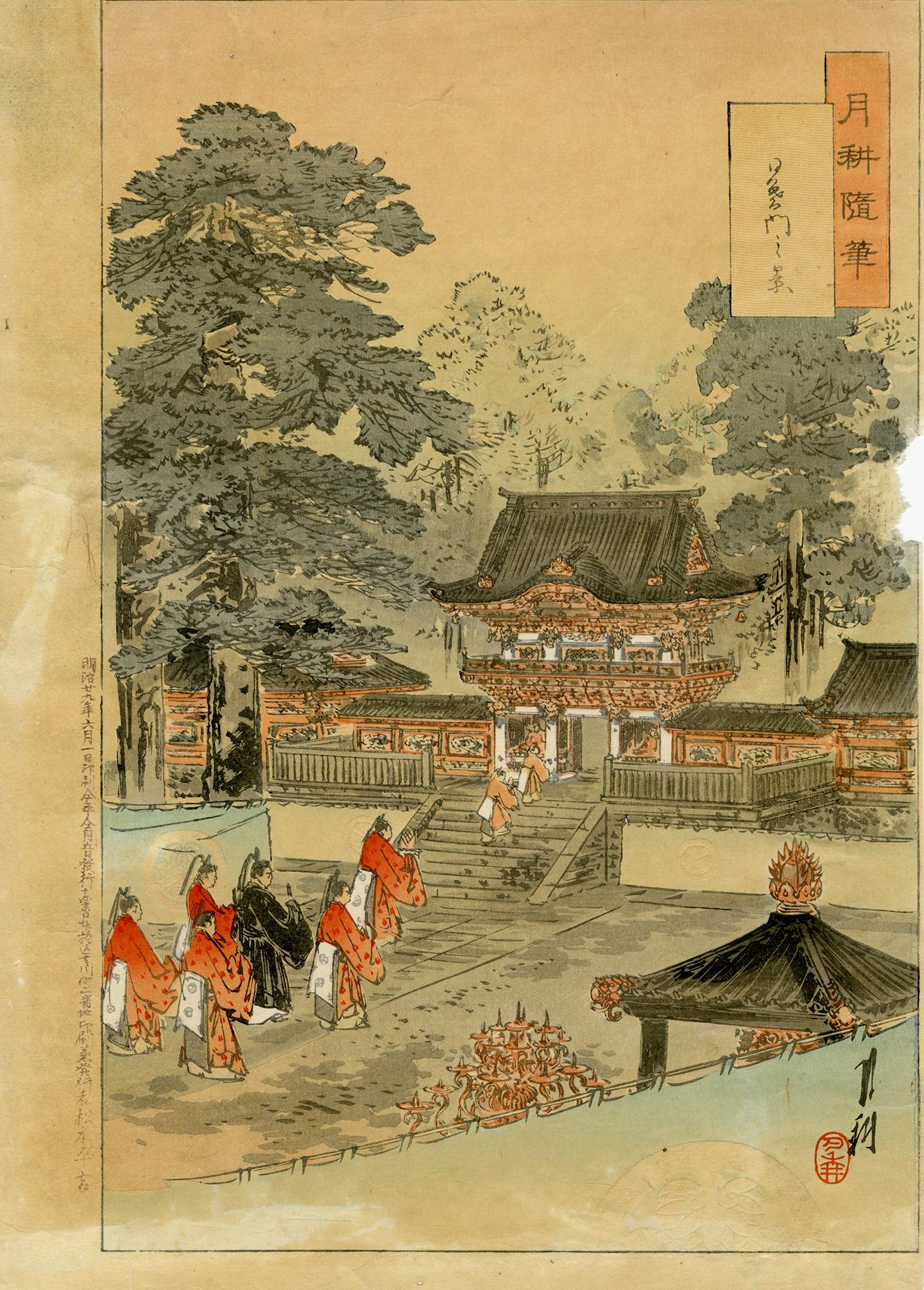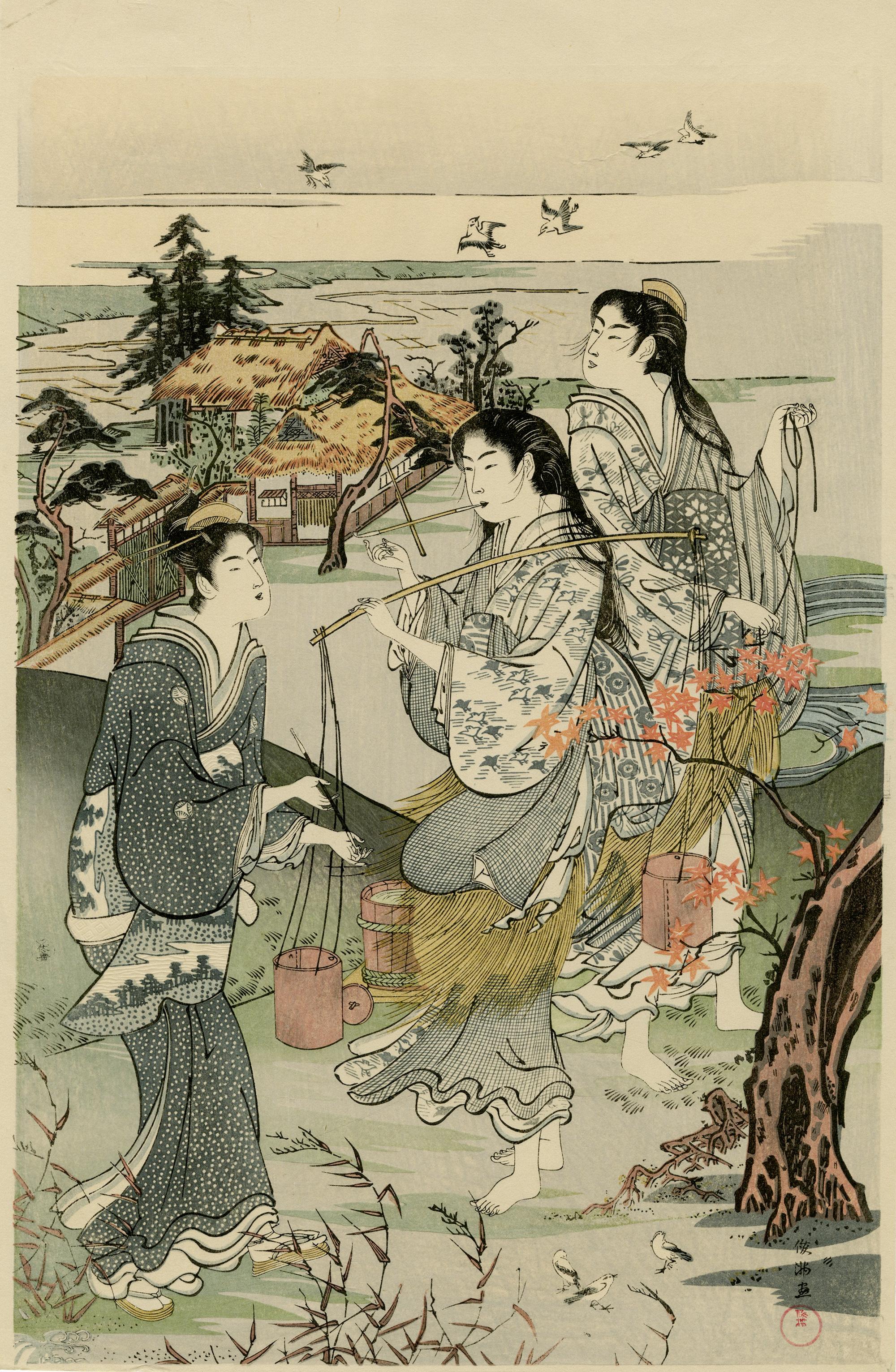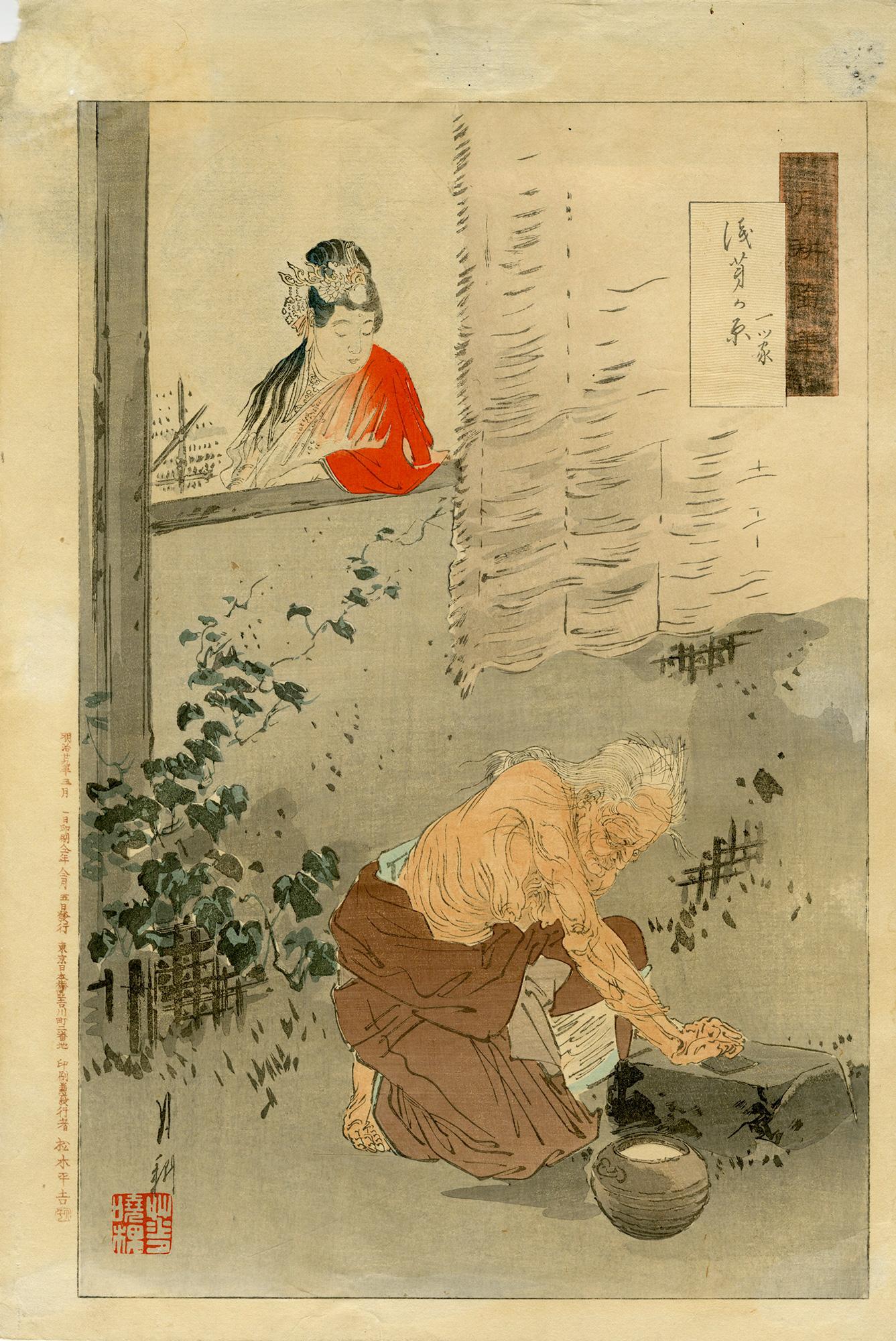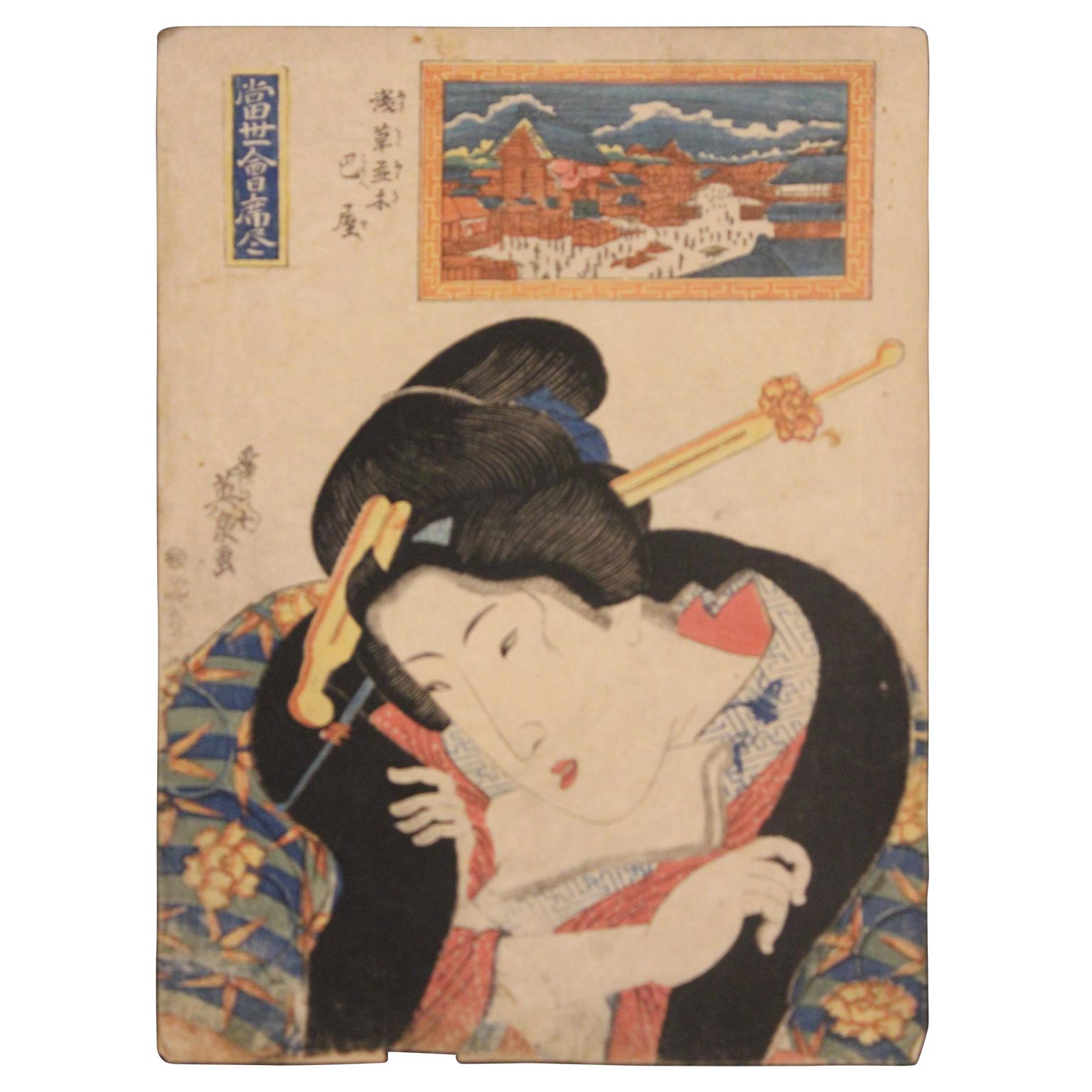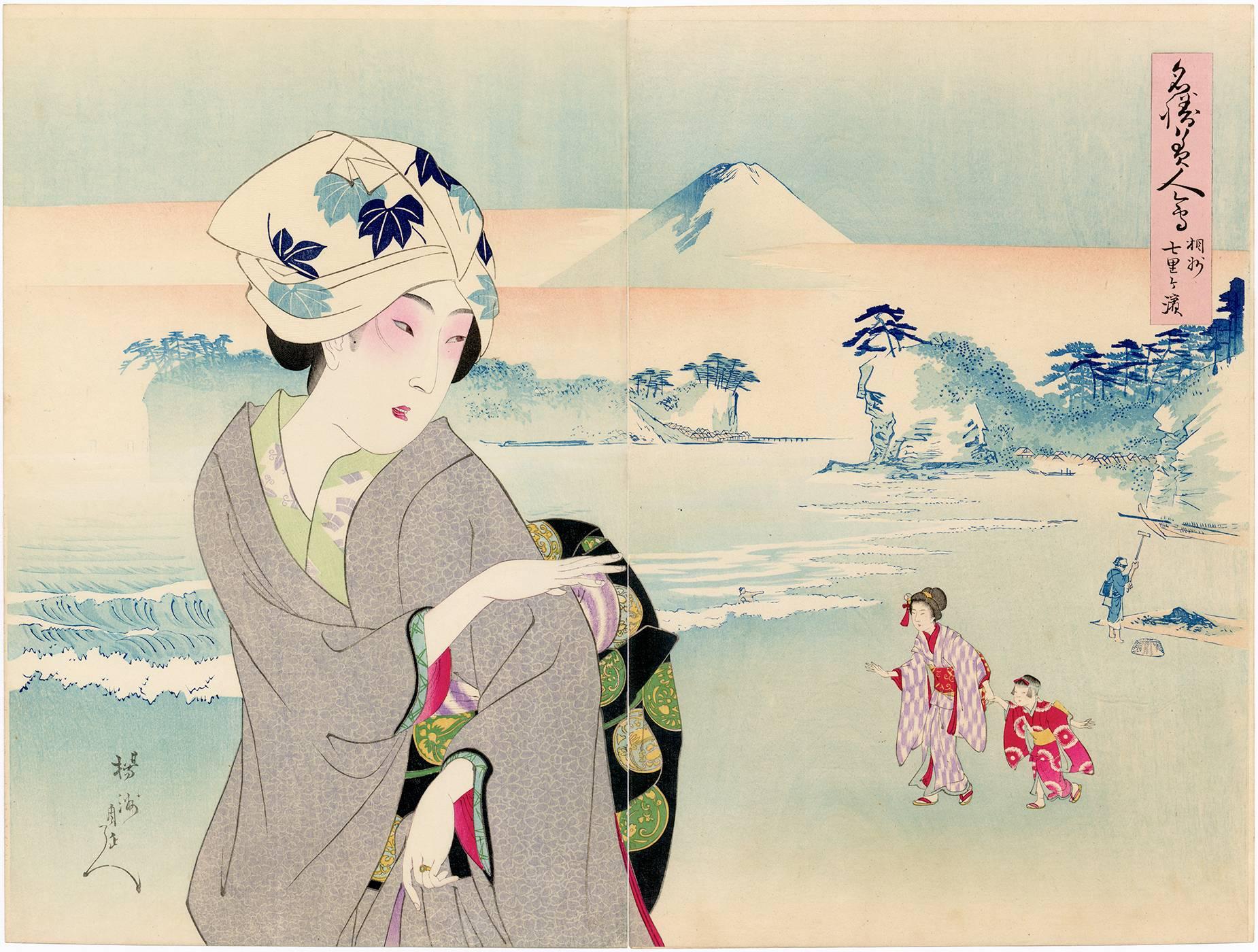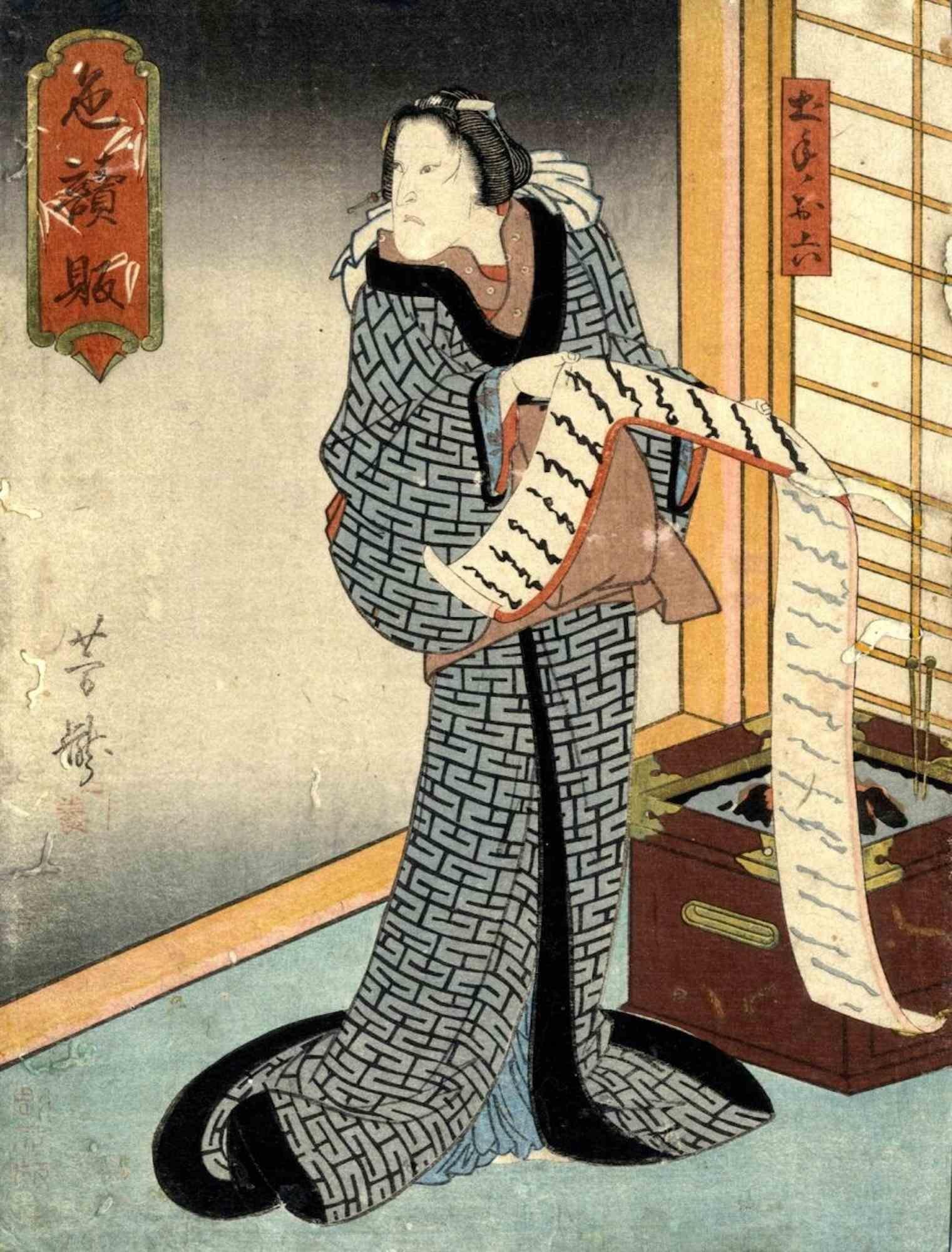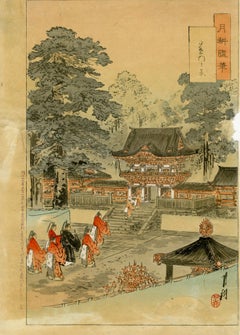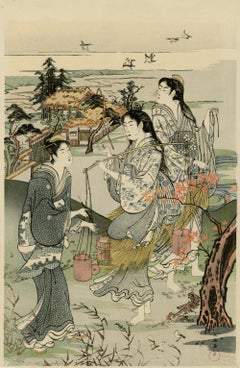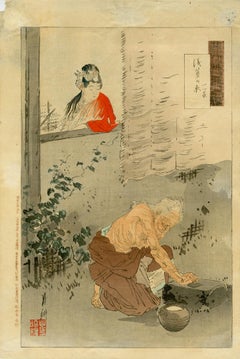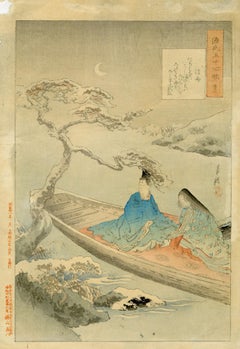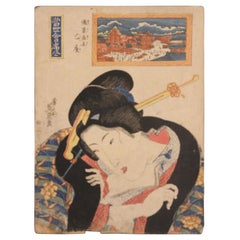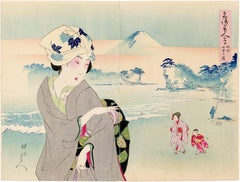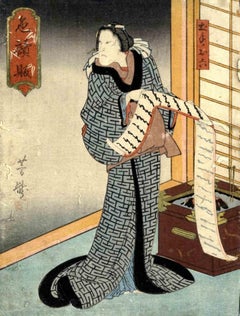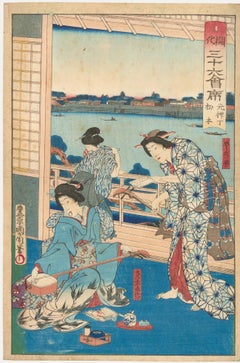Items Similar to Pilgrimage to Enoshima
Want more images or videos?
Request additional images or videos from the seller
1 of 3
Ogata GekkoPilgrimage to Enoshima1893
1893
$850
£636.53
€733.98
CA$1,194.71
A$1,305.22
CHF 684.71
MX$15,879.62
NOK 8,518.15
SEK 8,065.25
DKK 5,479.29
About the Item
Tokyo: Matsuki Heikichi, 1893
Woodcut in ink with embossing and hand-coloring in watercolor on handmade mulberry paper, 14 1/2 x 9 7/8 inches (368 x 251 mm), ōban tate-e, full margins. Scattered handling wear, adhesive residue on the verso, and minor edge losses at the left sheet edge and top right corner, well outside of image area. Meiji period (1868-1912), from the series of 47 essays and images called Sketches by Gekkō (Gekkō zuihitsu).
Ogaka Gekkō (originally known as Nakagami Masanosuke) was a self-trained artist who was orphaned at a young age and survived by illustrating brochures, selling drawings, and designing rickshaws. While the likes of Kitagawa Utamaro, Hishikawa Moronobu, Keisei Eisen, and Suzuki Harunobu were regarded as the innovators and masters of the bijin-ga form, Gekkō was one of the first Japanese woodblock print designers to achieve international recognition during his lifetime.
– Parkstone International, Looking Beyond the Portrait, November 5, 2015.
- Creator:Ogata Gekko
- Creation Year:1893
- Dimensions:Height: 14.5 in (36.83 cm)Width: 9.88 in (25.1 cm)
- Medium:
- Movement & Style:
- Period:
- Condition:
- Gallery Location:Middletown, NY
- Reference Number:Seller: BH12101stDibs: LU1979213771562
About the Seller
5.0
Vetted Professional Seller
Every seller passes strict standards for authenticity and reliability
Established in 2004
1stDibs seller since 2022
73 sales on 1stDibs
Typical response time: 7 hours
- ShippingRetrieving quote...Shipping from: Middletown, NY
- Return Policy
Authenticity Guarantee
In the unlikely event there’s an issue with an item’s authenticity, contact us within 1 year for a full refund. DetailsMoney-Back Guarantee
If your item is not as described, is damaged in transit, or does not arrive, contact us within 7 days for a full refund. Details24-Hour Cancellation
You have a 24-hour grace period in which to reconsider your purchase, with no questions asked.Vetted Professional Sellers
Our world-class sellers must adhere to strict standards for service and quality, maintaining the integrity of our listings.Price-Match Guarantee
If you find that a seller listed the same item for a lower price elsewhere, we’ll match it.Trusted Global Delivery
Our best-in-class carrier network provides specialized shipping options worldwide, including custom delivery.More From This Seller
View AllToshogu Shrine
Located in Middletown, NY
In image of the Tokugawa family paying homage to Tosho-gu Shrine in Nikko.
Tokyo: Matsuki Heikichi, 1896
Woodcut in ink with embossing and hand-coloring in watercolor on handmade m...
Category
Late 19th Century Edo Figurative Prints
Materials
Watercolor, Handmade Paper, Woodcut
Mu-Tamagawa
Located in Middletown, NY
Woodcut in ink with embossing and hand-coloring in watercolor on laid Japon paper, 16 x 10 inches (406 x 253 mm), ōban tate-e, full margins. Scattered handling wear and toning, other...
Category
Late 19th Century Edo Portrait Prints
Materials
Watercolor, Handmade Paper, Woodcut
The Lonely House at Asajigahara.
Located in Middletown, NY
A scene from a series of ghost stories and spooky rural legends.
Tokyo: Matsuki Heikichi, 1896.
Woodcut in ink with embossing and hand-coloring in watercolor on handmade mulberry pa...
Category
Late 19th Century Edo Figurative Prints
Materials
Watercolor, Handmade Paper, Woodcut
Courtiers under a wisteria draped pine tree
Located in Middletown, NY
Tokyo: Yokoyama Ryohachi, 1892
Woodcut in ink with embossing and hand-coloring in watercolor on handmade mulberry paper, 14 1/2 x 9 7/8 inches (368 x 251 mm), ōban tate-e, the full ...
Category
Late 19th Century Edo Portrait Prints
Materials
Watercolor, Handmade Paper, Woodcut
Two Women Playing Sugoroku from "Comparison of the Customs of Beauties."
Located in Middletown, NY
A scene from a vanishing Japan.
Two Women Playing Sugoroku from "Comparison of the Customs of Beauties."; The Customs and Manners of Women
Japan: Matsuki Heikichi, 1891.
Woodblock ...
Category
Late 19th Century Edo Figurative Prints
Materials
Watercolor, Handmade Paper, Woodcut
Actor Iwai Shigaku as Somenoi in "Denka chaya adauchi"
By Kuniyoshi
Located in Middletown, NY
Actor Iwai Shigaku as Somenoi in "Denka chaya adauchi" (Revenge at the Denka Teahouse), by Shigeharu, Ryusai (also called Kuniyoshi)
Tokyo: Horie Ichiba Wataki, 1835.
Woodcut on la...
Category
Early 19th Century Edo Portrait Prints
Materials
Laid Paper, Handmade Paper, Woodcut
You May Also Like
Biensennyo-ko Japanese Woodblock Print
By Keisai Eisen
Located in Houston, TX
Japanese Woodblock print of a Biensennyo-ko a powder face women. Behind the women is a framed cityscape. The print is possibly from the series "Eight Favorite Things in the Modern World". The woodblock print is printed on rice paper. The print is not framed.
Artist Biography: Keisai Eisen...
Category
Early 1800s Edo Portrait Prints
Materials
Woodcut
Beauties on the Beach with view of Mount Fuji
By Yoshu Chikanobu
Located in Burbank, CA
Shichirigahama, Sagami Province. A beauty in the foreground waves to her young companions, who run towards her on the beach. The beauty at left wears a western-style golden ring. We ...
Category
1890s Edo Landscape Prints
Materials
Handmade Paper, Mulberry Paper, Woodcut
Osakae - Woodcut by Ichiyôsai Yoshitaki - 1850s
By Ichiyôsai Yoshitaki
Located in Roma, IT
Osakae is an original artwork realized in the 1857 by Ichiyôsai Yoshitaki.
Woodcut print Chuban.
The actor Nakamura Kanjaku I as Dote no Oroku, scene in the first act third scene o...
Category
1850s Modern Figurative Prints
Materials
Woodcut
Toyohara Kunichika (1835-1900) - Woodblock, Kawacho Restaurant at Asakusa
By Toyohara Kunichika
Located in Corsham, GB
A charming Japanese woodblock print depicting three geishas playing instruments in a Kawacho restaurant. From Kaika sanjuroku kaiseki (Thirty-six famous restaurants and views of civi...
Category
Late 19th Century Figurative Prints
Materials
Woodcut
The Pilgrimage Procession to Kinryuzan Temple at Asakusa in the Eastern Capital
By Kuniyasu
Located in Soquel, CA
Japanese Parade - Woodblock Print
Japanese woodblock print by Utagawa Kuniyasu (歌川 国安) (Japan, 1794–1832). Japanese women, dressed in blue and red kimonos, are the focal point. A vi...
Category
Mid-19th Century Edo Figurative Prints
Materials
Paper, Ink, Woodcut
"Pictures Of Noh" - 1922 Original Japanese Woodblock Print
Located in Soquel, CA
"Pictures Of Noh" - 1922 Original Japanese Woodblock Print
Original Japanese woodblock print by Tsukioka Kogyo (Japanese, 1869-1927...
Category
1920s Edo Figurative Prints
Materials
Ink, Rice Paper, Woodcut
More Ways To Browse
Louis Marin Bonnet
Matisse Linocuts Pasiphae
Outdoor Finials
Richard Duardo
Sheriff Badge
Ultima Cena Vintage
Vanity Fair Jockey
Warhol Jacqueline
Abraham Lincoln Print
Amleto Dalla Costa
Andy Warhol Queen Elizabeth
Andy Warhol The Star
Bella Abzug
Catherine Howard
Dwarf Dancer
E H Artist
Exhibition Poster Edvard Munch
George Washington Pop Art
